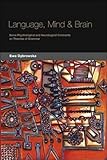Language, Mind and Brain : Some Psychological and Neurological Constraints on Theories of Grammar / Ewa Dabrowska.
Material type: TextPublisher: Edinburgh : Edinburgh University Press, [2022]Copyright date: ©2004Description: 1 online resource (280 p.)Content type:
TextPublisher: Edinburgh : Edinburgh University Press, [2022]Copyright date: ©2004Description: 1 online resource (280 p.)Content type: - 9780748614745
- 9781474466011
- 401.9
- online - DeGruyter
| Item type | Current library | Call number | URL | Status | Notes | Barcode | |
|---|---|---|---|---|---|---|---|
 eBook
eBook
|
Biblioteca "Angelicum" Pont. Univ. S.Tommaso d'Aquino Nuvola online | online - DeGruyter (Browse shelf(Opens below)) | Online access | Not for loan (Accesso limitato) | Accesso per gli utenti autorizzati / Access for authorized users | (dgr)9781474466011 |
Frontmatter -- Contents -- List of figures -- List of tables -- Acknowledgements -- Chapter 1 Introduction -- Part I The Basic Specifications -- Chapter 2 Language processing: speed and flexibility -- Chapter 3 Language acquisition: robustness -- Chapter 4 Language in the brain -- Chapter 5 Language and other cognitive processes -- Chapter 6 Biological underpinnings -- Part II The Building Blocks of Language -- Chapter 7 Words -- Chapter 8 On rules and regularity -- Chapter 9 Syntactic constructions -- Chapter 10 The cognitive enterprise -- Bibliography -- Index
restricted access online access with authorization star
http://purl.org/coar/access_right/c_16ec
GBS_insertPreviewButtonPopup('ISBN:9780748614752);Human languages reside in human brains, and it is undeniable that properties of the mind/brain place strong constraints on linguistic structure. Yet most linguists know little about the psychology of language and even less about its neural substrate. Language, Mind and Brain explores these constraints and shows how linguistics could benefit by incorporating insights from research on language acquisition, language processing, neurolinguistics and other disciplines concerned with human linguistic abilities. The first part of the book offers a useful introduction to the relevant issues for readers with little prior knowledge of these disciplines. In the second part, the cognitive underpinnings of language are discussed in more detail in three case studies chosen to illuminate complementary aspects of linguistic structure (the semantics of locative terms, morphological rules, the syntax of English questions). The final chapter is devoted to approaches to language which meet the requirements outlined earlier, with particular prominence given to cognitive and construction grammar.FeaturesA unique contribution to the debate on the relationship between language and other cognitive processesAccessible text which introduces readers to a psychologically realistic theory of languageIncludes a definitive introduction and case studies to illustrate key topics."
Mode of access: Internet via World Wide Web.
In English.
Description based on online resource; title from PDF title page (publisher's Web site, viewed 29. Jun 2022)


